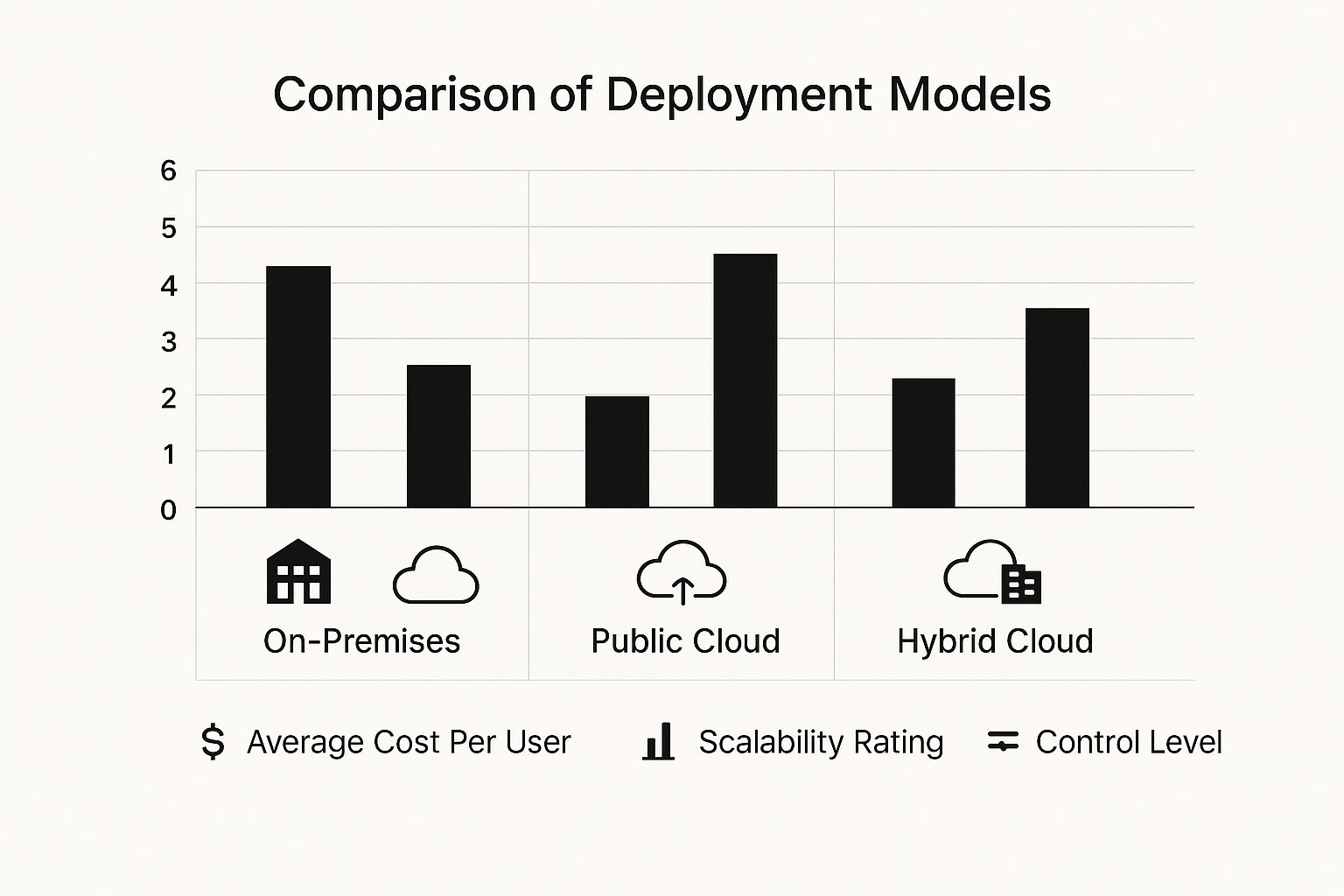Demystifying What Makes Cloud Adoption Strategy Actually Work

Many businesses in India are considering a move to the cloud. However, what distinguishes a successful cloud adoption strategy from one that merely consumes resources without yielding benefits? The answer isn't solely in embracing new technology; it’s about ensuring this move strongly supports fundamental business goals. Frequently, organizations adopt cloud solutions without a well-defined plan, resulting in costly missteps and lost chances.
Even with substantial financial commitment, a surprising number of organizations discover their cloud initiatives either slow down or don't produce the anticipated outcomes. Industry observations highlight that a common issue is often the gap between IT projects and broader business objectives. When this connection is missing, cloud efforts can end up as standalone technology updates instead of true business enablers, thereby not realizing their full potential and impacting the overall cloud adoption strategy.
The pursuit of new digital methods and innovation is accelerating the adoption of cloud services across India, making a carefully planned cloud adoption strategy extremely important. In fact, India's public cloud market is set for remarkable expansion, with predictions showing a compound annual growth rate (CAGR) of 24.3% from 2023 to 2028. This surge is anticipated to see the market increase from an estimated $5.2 billion in the first half of 2024 to an impressive $25.5 billion by 2028. Given this significant growth, Indian companies need a solid plan to take advantage of these opportunities and steer clear of frequent mistakes. Discover more about the projected growth of India's cloud market.
Strategic Foundations: Beyond The Tech
A winning cloud adoption strategy isn't just about selecting the correct cloud provider or services. It requires a significant change in perspective and careful, detailed planning. This process includes a straightforward evaluation of current business practices, recognizing possible obstacles, and making sure each action is in line with the company's overall vision. This early planning stage is key to achieving success in the long run.
Effective strategies usually include these important components:
- Clear Business Case: Clearly explaining how adopting cloud technology will lead to specific business results. This could mean expanding into new markets within India or making operations more efficient for teams working in different locations.
- Stakeholder Alignment: Making sure everyone, from top executives in major cities like Mumbai to technical teams in tech hubs like Bengaluru, grasps and backs the cloud vision and its goals.
- Realistic Roadmaps: Creating workable plans for moving to the cloud that consider complexities, available resources, and sensible timelines, avoiding overly hopeful forecasts.
- Proactive Risk Management: Spotting possible difficulties early on. Examples include data security issues related to Indian regulations or shortages of necessary skills among local staff, and then developing plans to address these.
The Crucial Mindset Shift: From IT Project To Business Accelerator
Possibly the most vital aspect of a fruitful cloud adoption strategy involves changing how the cloud journey is viewed. It shouldn't be seen just as an IT department's task focused on infrastructure; rather, it's a business transformation accelerator. This means looking at the cloud as a flexible platform that can encourage new ideas, improve responsiveness, and provide a competitive edge in India's active market.
When this change in thinking happens, backed by robust strategic planning and well-defined goals, organizations can genuinely tap into the cloud's capacity for change. Grasping these fundamental components—such as clear objectives, agreement among stakeholders, practical planning, and a focus on business needs—prepares the way for a deeper look into evaluating an organization's preparedness for this significant undertaking.
Honest Assessment: Knowing Where You Really Stand

Initiating a cloud adoption strategy without a precise understanding of your existing operational setup is a significant gamble, much like attempting a complex journey without a clear route. A candid and thorough assessment isn't just a preliminary task; it forms the very foundation for a successful move to the cloud. This process requires looking beyond superficial vendor checklists to genuinely grasp your organization's current standing.
Peeling Back the Layers: What to Assess
A detailed assessment carefully examines several crucial areas within your organization. This initial groundwork is fundamental for a successful cloud adoption strategy, particularly in a competitive market like India where informed and agile decision-making is key.
-
Infrastructure Audits: This involves more than simply cataloging servers; it's about uncovering the often unseen hidden dependencies between different systems and applications. Indeed, for a significant number of businesses—around 89%—pinpointing application dependencies presents the most substantial obstacle during cloud migration. This detailed audit helps map out the complex network of your current IT environment.
-
Application Portfolio Evaluation: Not all applications are equally prepared for the cloud. A practical evaluation will assist in categorizing your applications, distinguishing quick wins—those that can be migrated easily for immediate advantages—from applications that necessitate intricate refactoring or re-platforming.
-
Organizational Capabilities: Technology represents only one aspect of the overall picture. An honest evaluation of your team's current skills, existing operational processes, and general change readiness is essential. Identifying potential skill shortages early on enables timely training initiatives or strategic decisions to outsource certain functions, ensuring your team can capably manage the new cloud setup.
Beyond Surface-Level Checks
A truly beneficial assessment does more than just list assets. It uncovers potential obstacles and financial details that are frequently overlooked in a quick review, thereby strengthening your cloud adoption strategy.
Calculating the true Total Cost of Ownership (TCO) is a critical step. This calculation extends well beyond comparing server expenses; it must encompass migration costs, employee retraining, new software licensing fees, and potential shifts in operational procedures. It's quite telling that over 20% of organizations acknowledge they have limited clarity on how their cloud expenditures relate to different parts of their business, underscoring the necessity for meticulous financial examination.
Furthermore, proactively identifying security and compliance landmines is extremely important. Considering that nearly 47% of corporate data residing in the cloud is classified as sensitive, and with regulations like India's Digital Personal Data Protection Act in place, understanding your data's security status and compliance obligations from the very beginning can prevent significant issues down the line. For a more structured approach to these elements, you might find our guide on the Cloud Migration Checklist useful. Organizations that succeed tend to convert these assessment frameworks into actionable strategic roadmaps, which then direct their entire cloud adoption process, rather than viewing them as simple documentation exercises.
Choosing Cloud Models That Actually Fit Your Reality

Picking the right cloud service model is a key part of your cloud adoption strategy. It's about moving past marketing noise to meet real operational needs. This means making smart choices that fit your business situation in India, rather than just adopting global trends. The infographic above illustrates key differences between On-Premises, Public Cloud, and Hybrid Cloud, showing average costs, scalability, and control. It highlights that public cloud often excels in scalability and cost-effectiveness per user, while on-premises solutions provide maximum control, and hybrid models seek a practical balance.
Understanding IaaS, PaaS, and SaaS
When looking at cloud services, the main models are Infrastructure as a Service (IaaS), Platform as a Service (PaaS), and Software as a Service (SaaS). IaaS offers fundamental components like virtual machines and storage, giving you significant flexibility. In India's public cloud market, IaaS is currently the leading model. Projections indicate that by 2025, total public cloud revenue in the country is expected to reach approximately $12.75 billion. This shows how Indian businesses are increasingly using IaaS for better infrastructure adaptability and scaling capabilities, which are important for modernizing operations. You can find more details on this trend at Statista.
PaaS provides a platform to develop, run, and manage applications without needing to handle the underlying infrastructure. SaaS delivers software ready for use over the internet, such as email or CRM applications. Each model addresses different requirements; selecting the wrong one can result in expensive mistakes or operational issues, undermining your cloud adoption strategy.
To help clarify these distinctions and guide your decision-making, the table below provides a comparison of IaaS, PaaS, and SaaS, detailing control levels, management duties, and typical applications.
Cloud Service Model Comparison
A comprehensive comparison of IaaS, PaaS, and SaaS models showing control levels, management responsibilities, and ideal use cases
| Service Model | Control Level | Management Responsibility | Best Use Cases | Cost Structure |
|---|---|---|---|---|
| IaaS (Infrastructure as a Service) | High (OS, middleware, applications, data) | User: OS, middleware, applications, data, runtime. Provider: Servers, storage, networking, virtualization. |
Virtual machines, storage, networks, disaster recovery, development/test environments. | Pay-as-you-go for resources consumed. |
| PaaS (Platform as a Service) | Medium (Applications, data) | User: Applications, data. Provider: OS, middleware, runtime, servers, storage, networking, virtualization. |
Application development and deployment, analytics, database management. | Typically per application or platform usage. |
| SaaS (Software as a Service) | Low (User-specific configurations) | User: User access, data input. Provider: Entire stack (applications, data, runtime, middleware, OS, servers, storage, networking, virtualization). |
Email, CRM, office productivity suites, collaboration tools. | Subscription-based (e.g., per user/month). |
As the table illustrates, the primary differences lie in who manages what and the degree of flexibility you retain. Your specific technical needs and business goals will determine which model, or combination of models, is most suitable.
Smart Approaches to Hybrid and Multi-Cloud
Many organizations in India discover that a single cloud model doesn't cover all their needs. This is where hybrid cloud (a combination of private and public clouds) or multi-cloud (using services from several public cloud providers) strategies become practical. These methods can help:
- Avoid vendor lock-in, offering greater flexibility and negotiating power.
- Optimize costs by running workloads where they are most efficient.
- Address specific regulatory or data sovereignty requirements often found in the Indian market.
However, these approaches also bring increased complexity in terms of management and security. A well-thought-out decision framework is essential to ensure these choices match your organization’s technical skills and long-term business aims, rather than simply following industry trends. This helps keep your cloud adoption strategy both adaptable and enduring.
Building Migration Roadmaps That Survive Reality
Once you've identified suitable cloud models, the next crucial step in any cloud adoption strategy is the detailed planning of the migration itself. This phase is often where ambitious goals meet the friction of real-world complexities. To develop a migration roadmap that holds up under the pressure of execution, you need foresight, a clear understanding of different migration methods, and practical ways to make decisions. Without these, even a well-thought-out strategy can stumble.
Understanding Migration Patterns
Selecting the appropriate method for transferring your applications and data to the cloud is a foundational step. Teams typically evaluate several established migration patterns, each presenting unique benefits and difficulties. For example, one popular technique is "lift-and-shift", also known as rehosting. This involves moving applications to the cloud with very few alterations. While this can offer quicker initial results, it may not fully tap into cloud features and could result in increased costs over time if not planned well.
Alternatively, complete refactoring, or re-architecting, means overhauling applications to function natively in the cloud. This approach can yield the greatest advantages in areas like scalability and operational effectiveness, but it requires a significant investment in time, budget, and specialized knowledge. A critical factor for many, with nearly 89% of businesses reporting it as a hurdle, is grasping application dependencies before selecting a migration pattern. Ultimately, a candid evaluation of which method best supports business objectives and technical capabilities is essential. To help with this intricate stage, you might find our article on Data Migration Best Practices useful.
Practical Frameworks for Prioritization and Planning
A key element of a successful cloud adoption strategy is intelligent prioritization. While it might seem easier to move workloads based on how simple the technical task is, concentrating on business impact generally produces more favorable outcomes.
Here are some practical considerations:
- Workload Prioritization: Pinpoint applications that will provide the greatest value or solve pressing problems once they are moved to the cloud. This approach helps secure early successes and generates positive momentum.
- Realistic Timelines: Migrating to the cloud often uncovers unexpected technical debt or integration complications. It's important to create schedules that allow for these potential delays, avoiding overly hopeful timelines.
- Contingency Planning: Obstacles are almost guaranteed to arise. Developing thorough backup plans for essential workloads means that if a part of the migration runs into trouble, alternative solutions or rollback options are prepared.
Execution: Coordination and Continuity
Putting a migration roadmap into action is a detailed process that involves more than just the IT team. Organizations that navigate this well establish strong coordination among different departments to ensure operations remain stable.
Consider these points for effective execution:
- Cross-functional Teams: Engage individuals from various business areas, security teams, and operations staff right from the beginning. Open lines of communication and a common understanding of goals are crucial.
- Managing Expectations: Regularly update all involved parties on the migration's progress, any difficulties encountered, and changes to the schedule. Being open about these aspects helps manage expectations and keeps support strong.
- Business Continuity: During any migration, the top priority is to maintain business continuity. This requires detailed planning to reduce service interruptions and make sure essential services stay active during the entire transition, a process that can sometimes last for months or even years.
Taming Cloud Costs Before They Tame Your Budget

Many organizations, particularly in India, are drawn to the cloud for its potential cost benefits. However, the actual experience can differ, with 6 out of 10 organizations discovering their cloud spending surpasses what they initially planned. This unexpected 'bill shock' can transform hopes of streamlined cloud operations into a serious budget challenge, highlighting why cost management must be a central piece of any cloud adoption strategy.
Old-style budgeting, created for fixed IT expenses, often doesn't work well with the cloud's fluctuating costs. While the pay-as-you-go system offers adaptability, it can also result in spending spirals if not watched closely. Establishing strong cost governance early on is crucial, as expenses can climb quickly and surprise you when the invoice appears. Therefore, forward-thinking financial planning is a non-negotiable element of managing cloud resources effectively.
Practical Frameworks for Cloud Cost Control
To effectively manage cloud finances, businesses require sensible frameworks that embed cost control from the beginning. A common issue is a lack of transparency; for example, a significant 7 out of 10 companies confess they don't fully know where their cloud funds are going. This absence of insight, with over 20% of organizations unclear on how cloud expenses connect to various business units, severely hinders proper cost supervision.
One useful method is rightsizing resources. This practice involves making sure you pay only for the capacity you genuinely use, avoiding performance issues by not under-provisioning. It might include choosing correctly sized virtual machines or suitable storage options. Furthermore, setting up automated scaling enables resources to change with demand, which can save money during slower periods, but careful setup is vital to achieve these savings and avoid surprise charges.
Building a Culture of Cost Accountability
Technical fixes alone aren't enough; cultivating a company culture where teams consider cloud spending strategically is essential. This means putting systems in place to encourage responsibility and prevent runaway spending, which is thought to cause about 32% of cloud budgets to be wasted each year. For instance, when development teams are aware of the financial impact of the resources they use, they tend to choose more cost-effective options.
Ultimately, thriving organizations find a good balance between thorough cost optimization and fulfilling core business needs. The goal isn't merely to cut costs, but to invest intelligently to foster growth and new ideas. This involves setting up clear rules for governance, checking spending frequently, and making sure cloud investments support key business goals. This approach helps turn the cloud into a valuable tool, rather than an erratic cost, for businesses in India.
Cloud Cost Optimization Strategies
Key cost optimization techniques with implementation difficulty, potential savings, and timeline for results
Navigating the various methods for reducing cloud expenses can be a detailed task. To help with this, the table below lays out several Cloud Cost Optimization Strategies. It provides insights into the effort required for implementation, the potential financial benefits, the timeframe for observing these benefits, and the primary advantages associated with each tactic.
| Strategy | Implementation Effort | Potential Savings | Timeline | Key Benefits |
|---|---|---|---|---|
| Rightsizing Instances | Medium | High | Weeks to Months | Matches resource capacity to actual need, reduces waste from over-provisioning. |
| Reserved Instances/Savings Plans | Medium | High | Immediate | Significant discounts for long-term commitments on stable workloads. |
| Automated Scaling | Medium to High | Medium | Ongoing | Adjusts resources to demand, avoids paying for idle capacity. |
| Storage Tiering | Low to Medium | Medium | Months | Moves less frequently accessed data to cheaper storage, optimizes storage costs. |
| Identifying & Deleting Idle Resources | Low | Medium | Days to Weeks | Eliminates costs from unused VMs, storage, or other orphaned resources. |
| Cost Allocation & Tagging | Medium | Indirect (Visibility) | Ongoing | Improves visibility into spending by department/project, enables accountability. |
This table highlights that various approaches offer different impacts on savings and require distinct levels of effort. A tailored combination of these strategies, aligned with specific business needs and workload patterns, generally produces the most substantial results in effectively managing cloud expenditure.
Security That Actually Protects Your Cloud Investment
Often, it's security apprehension, rather than technical roadblocks or budget constraints, that can halt a cloud adoption strategy before it even starts. A strong security setup is about effectively dealing with actual threats, going beyond mere compliance lists to genuinely protect your important digital information as you move to and operate within the cloud.
Understanding The Shared Responsibility Model In Practice
A key idea in cloud security is the shared responsibility model. Consider it like this: your cloud service provider, such as Amazon Web Services (AWS), Microsoft Azure, or Google Cloud Platform (GCP), handles the security of the cloud. This means they protect the infrastructure that powers all cloud services, including their worldwide network, data centers, and the physical equipment. You, as the customer, are then responsible for security in the cloud.
This means your organisation in India is tasked with managing and securing:
- Your data.
- Your applications.
- User access and identities.
- Your operating systems and network configurations, which can vary based on the service model (e.g., Infrastructure as a Service).
Grasping your specific duties is essential for safeguarding sensitive information and adhering to Indian data protection laws.
Key Pillars Of Robust Cloud Security
Securing your cloud environment involves several important areas. A thorough cloud adoption strategy must include these elements from the very beginning:
- Identity and Access Management (IAM): This ensures only authorized people can access particular resources. Strong authentication, multi-factor authentication (MFA), and applying the principle of least privilege are critical, especially since almost 47% of corporate data stored in the cloud is classified as sensitive.
- Data Protection: Safeguarding your data means using encryption, both for data that is stored (at rest) and data that is being moved (in transit). Putting Data Loss Prevention (DLP) strategies into action, designed for cloud services, helps to stop accidental or intentional data breaches.
- Network Security: This includes setting up virtual private clouds (VPCs), security groups, and web application firewalls (WAFs) to manage traffic flow and defend against network-based attacks.
Advanced Security Approaches For Today's Threats
Beyond these foundational elements, a modern cloud adoption strategy also brings in advanced security measures. Adopting a Zero-Trust architecture, where no user or system is trusted by default, involves constantly checking every access request. This approach greatly shrinks the potential for attacks, and if planned carefully, doesn't have to create operational slowdowns.
Maintaining solid security during complex migrations is also very important. So is creating incident response procedures custom-made for cloud setups, rather than just modifying old on-premises plans. Clear, cloud-focused plans enable quicker and more effective actions if an incident does happen. You might find our detailed [Cloud Security Assessment Checklist](https://signiance.com/cloud-security-assessment-checklist/) useful for evaluating your current security setup. In the end, building security into every phase of your cloud journey is fundamental to protecting your investment.
Measuring What Matters: Beyond Uptime and Cost Savings
Evaluating the success of your cloud adoption strategy involves more than just maintaining service availability or cutting upfront costs. True, sustainable value becomes clear when you measure how cloud projects support real business progress, moving past simple technical wins like uptime figures. This approach centers on understanding how cloud efforts directly help your organization meet its strategic objectives, particularly in the active Indian market.
Key Performance Indicators (KPIs) Across the Organisation
Within any organization, various stakeholders will understandably focus on different metrics. For instance, engineering teams, possibly located in technology hubs such as Hyderabad or Pune, typically prioritize operational excellence. Their Key Performance Indicators (KPIs) could cover areas like:
- System reliability and availability
- Application performance and latency
- Resource utilisation efficiency
- Deployment frequency and success rates
For senior leadership and heads of business units, however, the attention moves to how the cloud adoption strategy supports larger business goals. Executives want to see measurements that show a competitive advantage and quick market reaction. This might include tracking how fast new products or services are launched in India's competitive environment, gains in customer acquisition or retention due to cloud-based features, or the overall impact on revenue growth and market share increase.
Implementing Effective Monitoring and Review Processes
To effectively track these varied and vital indicators, setting up dependable monitoring systems is crucial. These systems need to do more than just gather data; they must offer actionable insights. Such insights enable continuous improvement of your cloud adoption strategy by turning raw performance figures into clear evidence of business impact, which supports well-grounded decisions.
The necessity for this kind of precise measurement is highlighted by the considerable expansion in India's cloud industry. In 2024, the Indian cloud computing market was valued at $29.50 billion. It is expected to grow to $232.78 billion by 2033, reflecting a compound annual growth rate (CAGR) of 25.80% between 2025 and 2033. Initiatives like the IndiaAI mission from the government contribute to this significant growth, making it critical for businesses to measure their cloud investments accurately to make the most of these developments. You can Explore the Indian cloud market growth in detail for more information.
Ultimately, taking a data-driven approach allows for regular strategy reviews. This ensures your cloud initiatives stay flexible and can adjust to changing business requirements and market conditions. It fosters a culture of continuous optimization, positioning the cloud not merely as a service, but as a key strategic asset that consistently shows measurable business worth and aligns closely with your main organizational aims.
Are you prepared to realize the full benefits of your cloud investments through a data-focused plan? Signiance Technologies can assist your business in India to identify, measure, and refine the metrics that are most important for your success. Discover how Signiance can elevate your cloud journey to learn more.
